8.2 Using Inventory Custom Reports
ZENworks Control Center allows you to create and run custom reports that you can use to analyze the inventory in your Management Zone. These sections provide more information:
8.2.1 Available Custom Reports
ZENworks Control Center includes several predefined reports you can use to analyze the inventory in your Management Zone. These reports are grouped into folders according to their function. The available folders and reports are as follows:
-
Hardware Components (folder): Reports focusing on hardware components, such as BIOS and system details.
-
BIOS and System Details: Shows the BIOS details for all current systems.
-
Hardware added or deleted in last 6 months: Lists the hardware components in the Management Zone and shows the number of additions and deletions over the previous 6 months.
-
USB devices added in last 30 days: Shows the workstations that have had a USB device added in the previous 30 days.
-
Workstations with memory deletions in last 30 days: Shows the workstations that have had memory module deletions during the previous 30 days.
-
-
Local Product Creation (folder): Reports focusing on software files that can be used to create Local Software Products. For more information on Local Software Products, see Section 6.0, Creating Local Software Products.
WARNING:If you rename, move or delete the Local Product Creation folder or its contents, you will not be able to create the Local Software Products.
-
Software Files by Machine: Shows the software files on each machine. You can use this report to create Local Software Products.
-
Unique Software Files: Shows the software files along with Version Resource Block (VRB) data. You can use this report to create Local Software Products.
-
-
Software Applications (folder): Reports focusing on software applications, such as how many applications were added during a specified time.
-
SW apps added in last 30 days (by product): Shows the software applications that were added during the previous 30 days, grouped by product.
-
SW apps added in last 30 days (by workstation): Shows the software applications that were added during the previous 30 days, grouped by workstation.
-
SW apps deleted in last 30 days (by product): Shows the software applications that were deleted during the previous 30 days, grouped by product.
-
SW apps deleted in last 30 days (by workstation): Shows the software applications that were deleted during the previous 30 days, grouped by workstation.
-
Workstations with antivirus software: Shows the Windows workstations (not marked as deleted) with antivirus software installed.
-
Workstations with suspicious software installed: Shows the workstations with suspicious software installed.
-
Workstations without antivirus software: Shows the Windows workstations (not marked as deleted) without antivirus software installed.
-
-
Systems (folder): Reports focusing on system details, such as how many systems were added during a specified time.
-
Hosts of Virtual Machines: Shows the systems that are hosting virtual machines.
-
Systems added in last 90 days: Shows the systems (Windows, UNIX/Linux) that were added to the inventory database during the last 90 days.
-
Systems deleted in last 90 days: Shows the systems (Windows, UNIX/Linux) that were deleted during the previous 90 days.
-
Systems that have not loaded results in 90 days: Shows the systems (Windows, UNIX/Linux) that have not been marked as deleted and have not loaded scan results during the previous 90 days.
-
Systems with less that 100 MB free space: Shows the systems (Windows, UNIX/Linux) that have not been deleted and have less than 100MB free disk space.
-
Systems with less that 128 MB memory: Shows the systems (Windows, UNIX/Linux) that have not been deleted and have less than 128MB total memory.
-
Virtual Machines: Shows the virtual machines in your Management Zone.
-
8.2.2 Running a Custom Report
-
In ZENworks Control Center, click .
-
In the Inventory Custom Reports panel, click the folder containing the report you want to run.
The number of reports in each folder is shown in the column.

-
Click a report.
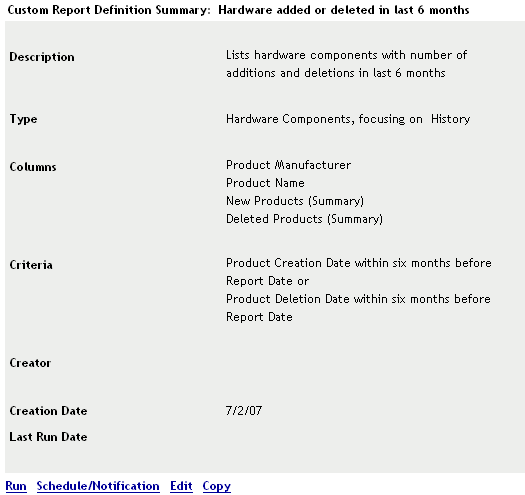
-
Click in the lower left corner.
On the report page, click the various links on the report for additional information. You can export the report to an Excel, CSV, or PDF format by clicking the corresponding link.
8.2.3 Creating a Custom Report
-
In ZENworks Control Center, click .
-
In the Inventory Custom Reports panel, click the folder where you want to save the report, or create a new folder by clicking , specifying a folder name, then clicking .
-
Click .
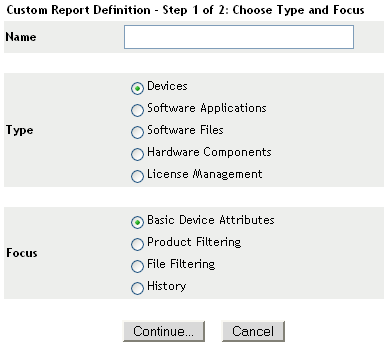
-
Specify a name in the field.
-
Select the report type. The types are:
-
Devices
-
Software Applications
-
Software Files
-
Hardware Components
-
License Management
-
-
Select the focus of the report. The options are:
-
Basic Device Attributes
-
Product Filtering
-
File Filtering
-
History
-
-
Click .
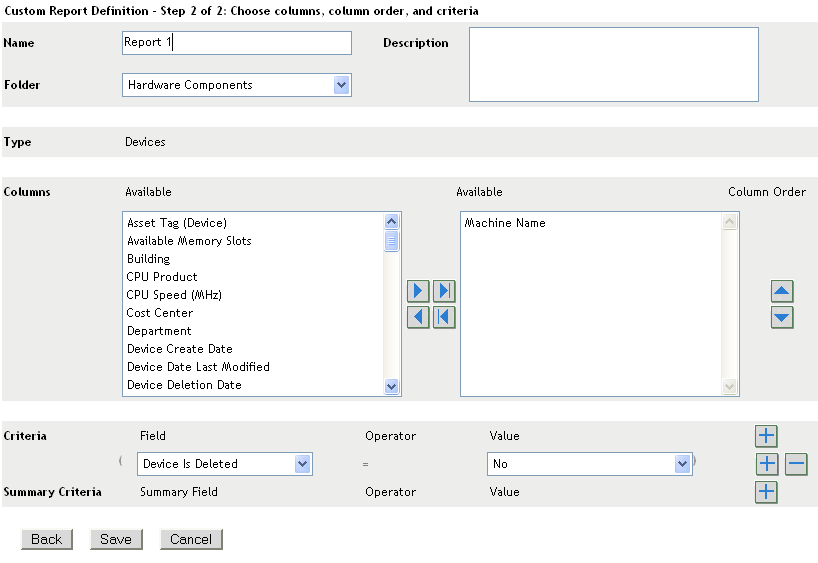
-
Fill in the following fields:
Name: Specify the name of the report.
Folder: Select a folder where you want to save the report.
Description: Specify a description for your report.
Type: This field is display only. It shows the report type you selected.
Columns: From the list on the left, select what data you want to include in your report. Use the arrow icons to move the selected data to the list on the right. Use Ctrl+click to select more than one option at a time. Use the up and down icons to arrange how you want the data displayed.
Criteria: Select your filter criteria in the , , and fields. Use the + icons to add filters; click the - icon to delete a filter. Click or to toggle back and forth between the two operators.
Summary Criteria: Select your summary filter criteria in the , , and fields. Use the + icons to add filters; click the - icon to delete a filter. Click or to toggle back and forth between the two operators
-
Click .
8.2.4 Scheduling a Custom Report and Sending Notifications
You can schedule a report to run automatically and send out notifications to specified people when the report is ready. To schedule a report and configure notifications:
-
In ZENworks Control Center, click .
-
In the Inventory Custom Reports panel, click the folder containing the report you want to schedule.
-
Click the report you want to schedule.

-
Click .
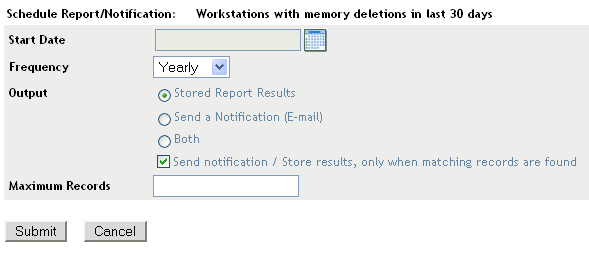
-
Fill in the following fields:
Start Date: Click the calendar icon to specify a date.
Frequency: Select how often you want to send the notification: yearly, monthly, weekly, daily, once, or never.
Output: Select whether you want to store the report, send an e-mail notification that the report is ready, or both. You can also choose to store the results or send a notification only when matching records are found. For information on configuring e-mail addresses, see Section 8.2.5, Configuring E-mail Addresses.
Maximum Records: Specify the maximum number of records to store.
-
Click .
8.2.5 Configuring E-mail Addresses
You can send notifications to selected people when a custom report is run. To do this, you need to import the e-mail addresses of those you want to notify into ZENworks Control Center. For information on sending notifications, see Section 8.2.4, Scheduling a Custom Report and Sending Notifications.
The E-mail Addresses panel on the Configuration page allows you to import e-mail addresses that can be used to send notifications when a custom report is ready, as configured in the report definition. Previously imported e-mail addresses are listed in the panel, along with the user’s first, last, and middle name.
To import e-mail addresses:
-
In ZENworks Control Center, click .
-
Click the Asset Inventory tab.
-
In the E-mail Addresses Panel, click .

-
In the field, select either or .
If you select , the e-mail addresses found in an inventory scan will be imported. If you select , specify the file location in the field. Use the first name,middle name,last name,email address format to save the CSV file.
For example, if the name is Wen Zeng Hong and the email address is wzh@gmail.com, specify the file location as Wen,Zeng,Hong,wzh@gmail.com. If there is no middle name, Zeng, save the CSV file as Wen,,Hong,wzh@gmail.com.
-
Click .
-
Click .
To delete all e-mail information:
-
In ZENworks Control Center, click .
-
In the E-mail Addresses Panel, click .
-
Click .
-
Click .
All e-mail information is deleted.
8.2.6 Editing a Custom Report
-
In ZENworks Control Center, click .
-
In the Inventory Custom Reports panel, click the folder containing the report you want to edit.
-
Click the report.

-
Click in the lower left corner.
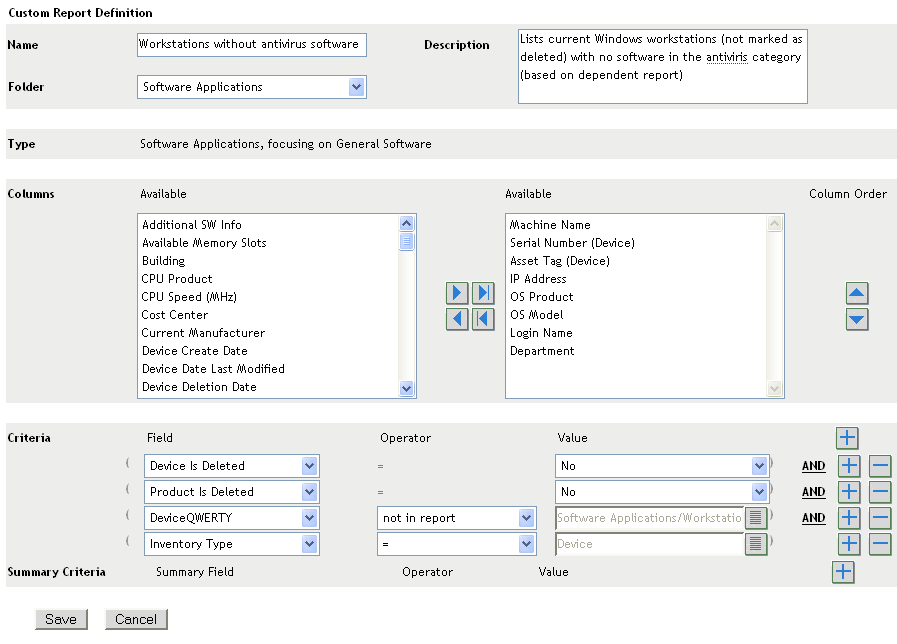
-
Edit the following fields:
Name: The name of the report.
Folder: The folder where you want to save the report.
Description: The description for your report.
Type: This field is display only. It shows the report type you selected.
Columns: From the list on the left, select what data you want to include in your report. Use the arrow icons to move the highlighted data selection to the list on the right. Use Ctrl-click to select more than one option at a time. Use the up and down icons to arrange how you want the data displayed.
Criteria: Select your filter criteria in the , , and fields. Use the + icons to add filters; click the - icon to delete a filter. Click or to toggle back and forth between the two operators.
Summary Criteria: Select your summary filter criteria in the , , and fields. Use the + icons to add filters; click the - icon to delete a filter. Click or to toggle back and forth between the two operators.
-
Click .
8.2.7 Moving a Custom Report
-
In ZENworks Control Center, click .
-
In the Inventory Custom Reports panel, click the folder containing the report or reports you want to move.
-
Select the report or reports you want to move.
-
Click .
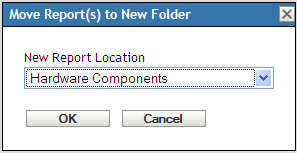
-
Select a new folder location.
-
Click .
WARNING:If you move reports in the folder, you will not be able to create the Local Software Products.
8.2.8 Deleting a Custom Report or Folder
To delete a custom report:
-
In ZENworks Control Center, click .
-
In the Inventory Custom Reports panel, click the folder containing the report you want to delete.
-
Select the report you want to delete.
-
Click .
To delete a folder:
-
In ZENworks Control Center, click .
-
In the Inventory Custom Reports panel, select the folder you want to delete.
-
Click .
WARNING:
-
If you delete reports in the folder, you will not be able to create the Local Software Products.
-
Deleting a folder deletes all the reports in that folder.
-
8.2.9 Viewing Scheduled Reports by Date and Title
Reports that are run on a schedule are stored in a database. You can view these reports either by title or date. For information on scheduling reports, see Section 8.2.4, Scheduling a Custom Report and Sending Notifications.
To view a scheduled report by date or title:
-
In ZENworks Control Center, click .
-
In the Inventory Custom Reports panel, click one of the following:
The Scheduled Reports by Grouping page opens and shows the saved scheduled custom reports grouped by date or title and a report count. Click the date or title to open the page, where you can select a report and view it. To delete a group of reports, select the group and click .

-
8.2.10 Importing New Report Definitions
If you have defined reports in ZENworks Asset Management 7.5, you can import them into ZENworks Control Center. You can also re-import reports that have been exported by ZENworks Control Center. A predefined XML format is needed for import.
To import report definitions:
-
In ZENworks Control Center, click .
-
In the Inventory Custom Reports panel, click .

-
Specify the file in the field, or click to search.
-
Click .